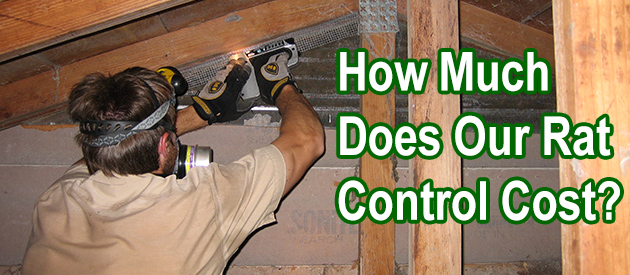Madison County, Huntsville Rat Control Situation:
Hi David, I found your website online -- very informative for removing rats and squirrels from attics. My problem is the animal(s), which I'm guessing are rats or mice because they only scratch at night, is in the ceiling, but there is no attic or crawl space. The structure is a two story condo and the scratching sound is in the same location for the past 2 - 3 nights: in the ceiling of the small landing between the two upstairs bedrooms. There is a recessed light in that ceiling, and removing the light cover does provide a small access into the ceiling. The actual hole is about 6 - 7" wide, but there is an old-style light can in the hole, which only has a few small openings in it. Last year prior to painting the ceiling we removed the light cover and down came some animal droppings. Even though we weren't hearing any animal noises at that time, we set two Victor mouse traps which we were able to fit inside the small openings. We didn't catch anything so eventually, we just put the light cover back on. Now, there is very active scratching in the ceiling a few inches from the light so there is definately something alive in there. If it's a mouse, we can probably set a trap like we did before and I believe there is enough of an opening to remove the trap with a mouse in it. If it's a larger critter like a rat, we may or may not be able to set the larger trap and/or remove the trap with the dead animal because the opening may be too small. Even if we are successful at trapping and removing the animal, there is little access to remove the droppings or see if they've done any damage in there. Any suggestions you have would be greatly appreciated. Thanks. Nicole in Huntsville AL
Between floors is hard. If you can get a trap inside, great. You still need to Inspect the house and find out how the rodents are getting inside and seal up every single last entry/exit hole and gap with steel.
Huntsville Rat Control Tip of The Week
New York City's Rat Problem
The Norway Rat:
The majority of rats in New York City are Norway rats, otherwise known as brown rats. Brown rats typically weigh 1 pound and they can grow up to 16 inches long. A brown rat needs just 1 ounce of food and water every day to survive.
Agile Creatures:
Brown rats are known for their ability to climb through pipes and get through small spaces. Even though some of the largest brown rats can be up to 20 inches long and weigh more than 2 pounds, it's easy for them to fit through a hole that's the size of a quarter. Rats have some serious superpowers and are capable of falling up to five stories without any injury and leaping up to 4 feet for climbing.
Going Through Any Material:
Rats also have extremely strong jaw muscles and quality teeth. There are rats in New York that are capable of chewing through cinderblocks and sewer pipes.
Where Rats Live:
Most rats will rarely travel more than 600 feet away from the area that they were born. Most rats like to nest and burrow in soft ground as well as below ground to live in colonies. A rat colony is usually between 30 to 50 rats and the number of rats in a burrow or family is usually between 8 to 12. Rats stay close to their food source and they can often be found just a few hundred feet from where they go every day to be fed. Public garbage areas, alleyways, and more can be a hotbed for rats and NYC produces its own information portal on areas where rats are heavily concentrated.
Massive Population:
It's estimated that there are roughly 2,000,000 rats in New York City and this means that the rat population in New York City sits around 25% of the total number of humans.


